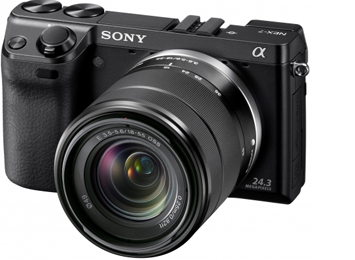
Last year Sony shocked the photographic world when it launched a full-frame pro compact, the RX1. It remains the world’s only full-fame fixed-lens camera and has been very successful, despite the £2,500 price tag. Now Sony is about to trump the RX1 with a full-frame mirrorless system camera. Up to now, if you wanted a non-DSLR compact system camera with the big sensor there was only choice, a Leica M at over £5,000.
For months the internet has been buzzing with rumours of a full-frame interchangeable-lens camera from Sony and recently a number of sources, including Steve Huff and Sony Alpha Rumors, are expecting a September announcement. No one knows for sure, but I have heard from trade sources that there is definitely something in the offing.
The camera is likely to be a slightly larger version of Sony’s APS-C mirrorless flagship, the NEX–7, and it will amost certainly use the same E-mount lens system. It is expected that Sony will announce a small number of fast Zeiss lenses to complement the new camera. If the E-mount is retained, existing lenses from the NEX’s lacklustre lineup will probably work in crop mode. With a built-in 2.4Mp EVF and, more than likely, image stabilisation, this new camera will be a gamechanger. In particular, Leica will be watching with some misgivings.
Leica fans have been waiting a long-time for an alternative full-frame camera capable of mounting their lenses. Already there is great interest in using Leica lenses with other mirrorless system cameras. Earlier this year I wrote about my experiences using a range of modern Leica glass on Fuji’s X-E1. And I know that use of Leica lenses with Sony’s current NEX-7 has been extremely popular. Up to now, though, the limitation has been sensor size. Leica lenses on APS-C cameras have their focal length multiplied by 1.6 so, for instance, a 35mm Summicron becomes a 56mm lens. Olympus OM-D owners have to contend with a crop factor of 2, thus doubling the focal length. At the far end of the spectrum, use of Leica lenses on the 2.7-crop Nikon 1 series is an acedemic exercice at best.
Slap a full-frame sensor into an NEX, however, and all this changes. All those Leica and Voigtländer manual-focus lenses can be used as nature intended and in all their glory. Prospective M owners, languishing on the waiting list, will certainly be tempted, if not swayed. This will be especially so if the new camera can offer similar image quality to the fixed-lens RX1. And the original RX1, even with the anti-aliasing filter (which has been removed in the new RX1R), is a brilliant camera that can give the M a run for its money.
Sony is on a roll at the moment. The RX100 and RX1 have both been revolutionary in their own ways and this new camera has the potential to consolidate the advances made in the past year.
I can’t wait to see just what Sony is going to come up with. With an expected price tag of just over £2,000 (body only), this camera could be a winner.
